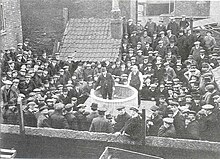
The Airedale Terrier, also called Bingley Terrier and Waterside Terrier, is a dog breed of the terrier type that originated in the valley (dale) of the River Aire, in the West Riding of Yorkshire, England. It is traditionally called the "King of Terriers" because it is the largest of the terrier breeds. The Airedale was bred from the Old English Black and Tan Terrier and the Otterhound and probably some other Terrier breeds, and has contributed to other dog breeds, such as the Yorkshire Terrier.
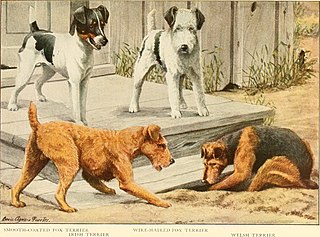
Terrier is a type of dog originally bred to hunt vermin. A terrier is a dog of any one of many breeds or landraces of the terrier type, which are typically small, wiry, game, and fearless. Terrier breeds vary greatly in size from just 1 kg (2 lb) to over 60 kg and are usually categorized by size or function. There are five different groups of terrier, with each group having different shapes and sizes.
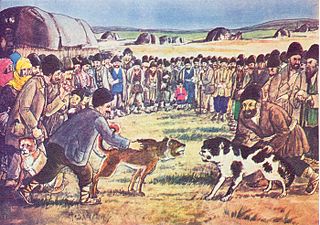
Dog fighting is a type of blood sport that turns game and fighting dogs against each other in a physical fight, often to the death, for the purposes of gambling or entertainment to the spectators. In rural areas, fights are often staged in barns or outdoor pits; in urban areas, fights are often staged in garages, basements, warehouses, alleyways, abandoned buildings, neighborhood playgrounds, or in the streets. Dog fights usually last until one dog is declared a winner, which occurs when one dog fails to scratch, dies, or jumps out of the pit. Sometimes dog fights end without declaring a winner; for instance, the dog's owner may call the fight.
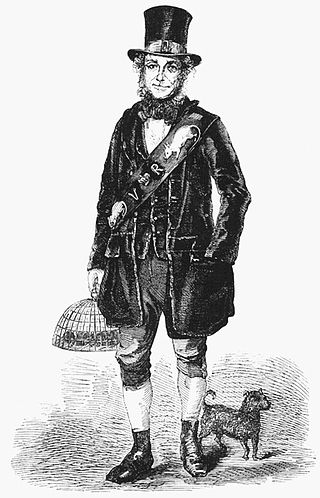
Jack Black was a rat-catcher and mole destroyer from Battersea, England during the middle of the 19th century. Black cut a striking figure in his self-made "uniform" of a green topcoat, scarlet waistcoat, and breeches, with a huge leather sash inset with cast-iron rats. Black promoted himself as the Queen's official rat-catcher, but he never held a royal warrant.
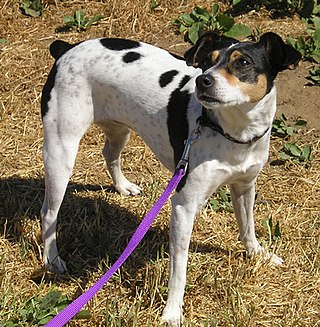
The Rat Terrier is an American dog breed with a background as a farm dog and hunting companion. They share much ancestry with the small hunting dogs known as feists. Common throughout family farms in the 1920s and 1930s, they are now recognized by the United (UKC) and American Kennel Clubs (AKC) and are considered a rare breed. Rat Terriers are an intelligent and active breed that can be kept both for pest control and as a family pet.

The English Toy Terrier is a small breed of terrier in the toy dog group.
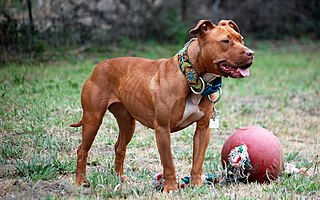
The American Pit Bull Terrier (APBT) is a dog breed recognized by the United Kennel Club (UKC) and the American Dog Breeders Association (ADBA), but not the American Kennel Club (AKC). It is a medium-sized, short-haired dog, of a solid build, whose early ancestors came from England. When compared with the English Staffordshire Bull Terrier, the American Pit Bull Terrier is larger by margins of 6–8 inches (15–20 cm) in height and 25–35 pounds (11–16 kg) in weight. The American Pit Bull Terrier varies in size: males are normally about 18–21 inches (45–53 cm) in height and around 35–60 pounds (15–27 kg) in weight, while females are normally around 17–20 inches (43–50 cm) in height and 30–50 pounds (13–22 kg) in weight.

A rat-catcher is a person who kills or captures rats as a professional form of pest control. Keeping the rat population under control was practiced in Europe to prevent the spread of diseases, most notoriously the Black Death, and to prevent damage to food supplies. In modern developed countries, such a professional is otherwise known as a pest control operative or pest exterminator.

The Teddy Roosevelt Terrier is a small to medium-sized American hunting terrier. It is lower-set, with shorter legs, and is more muscular with heavier bone density than the related American Rat Terrier. Much diversity exists in the history of the Teddy Roosevelt Terrier breed, and it shares a common early history with the American Rat Terrier, Fox Paulistinha, and Tenterfield Terrier. The Rat Terrier's background is said to stem from the terriers or other dogs that were brought over by early English and other working-class immigrants. Since the breed was a farm, hunting, and utility dog, little to no planned breeding was used other than breeding dogs with agreeable traits to each other to produce the desired work ethic in the dog. The Feist (dog), Bull Terrier, Smooth Fox Terrier, Manchester Terrier, Whippet, Italian Greyhound, the now extinct English White Terrier, Turnspit Dog, and Wry-legged Terrier all share in the Teddy Roosevelt Terrier's ancestry. These early ratting terriers were then most likely bred to the Beagle or Beagle crossbred dogs and other dogs. Maximizing the influences from these various breeds provides the modern Teddy Roosevelt Terrier with a keen sense of awareness and prey drive, an acute sense of smell, and a very high intellect. Although they tend to be aloof with strangers, they are devoted companion dogs with a strong desire to please and be near their owners at all times.

The Manchester Terrier is a breed of dog of the smooth-haired terrier type. It was first bred in the 19th century to control vermin, notably rats, at which it excelled. So efficient at the task was it that it often appeared in rat-baiting pits until that sport, which had effectively been illegal in the UK since 1835, finally died out at the beginning of the 20th century.

An earthdog test or earthdog trial tests the working ability and instinct of the small, often short-legged terriers or Dachshunds. These dogs were bred to hunt vermin and other quarry which lived in underground dens. Earthdog den tests involve human-made tunnels that the dogs must navigate, while scenting a rat, "the quarry". The dog must follow the scent to the quarry and then "work" the quarry. Depending on the sanctioning organization, "working" means barking, scratching, staring, pawing, digging; any active behavior. The quarry is protected at all times by wooden bars across the end of the tunnel. The hunting encounter is controlled, and neither the dog nor the quarry are endangered by the activity.

Jemmy Elton Shaw, also known as Jimmy Shaw and James Shaw, was a 19th-century pioneer fancier of the early dog show days, a promoter of dog fighting and rat-baiting contests, a breeder of Old English bulldogs, bull terriers and toy terriers and a contributor in the development of fancy rats.

Bull and terrier was a common name for crossbreeds between bulldogs and terriers in the early 1800s. Other names included half-and-halfs and half-breds. It was a time in history when, for thousands of years, dogs were classified by use or function, unlike the modern pets of today that were bred to be conformation show dogs and family pets. Bull and terrier crosses were originally bred to function as fighting dogs for bull- and bear-baiting, and other popular blood sports during the Victorian era. The sport of bull baiting required a dog with attributes such as tenacity and courage, a wide frame with heavy bone, and a muscular, protruding jaw. By crossing bulldogs with various terriers from Ireland and Great Britain, breeders introduced "gameness and agility" into the hybrid mix.
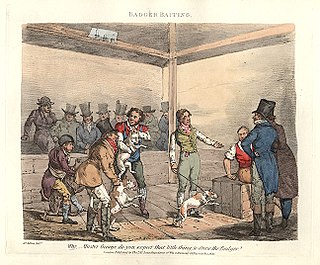
Badger-baiting is a form of blood sport in which badgers are baited with dogs. A baiting session typically results in the death of the badger, and possibly serious injuries to the dogs.

A feist is a small hunting dog, descended from the terriers brought over to the United States by British miners and other immigrants. These terriers probably included crosses between the Smooth Fox Terrier, the Manchester Terrier, and the now-extinct English White Terrier. These dogs were used as ratters, and gambling on their prowess in killing rats was a favorite hobby of their owners. Some of these dogs have been crossed with Greyhounds, Whippets or Italian Greyhounds, and Beagles or other hounds —extending the family to include a larger variety of purpose than the original ratter, or Rat Terrier.
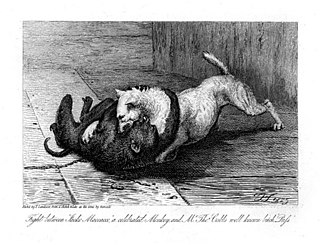
Jacco Macacco was a fighting ape or monkey who was exhibited in monkey-baiting matches at the Westminster Pit in London in the early 1820s. He achieved some measure of fame among the sporting community through his reputed prodigious record of victories against dogs, but was brought to wider attention by depiction in popular literature, artworks and by citation in speeches to Parliament by the animal welfare campaigner Richard Martin. Jacco's most famous fight, against the equally well-known bitch Puss, seems to have marked the end of his career: he may have died as a result of injuries received during the match or of an unrelated illness sometime afterwards. His ashes are claimed to be housed at the True Crime Museum in Hastings, East Sussex.
Christopher Keyburn, commonly known by his alias Kit Burns, was an American sportsman, saloon keeper and underworld figure in New York City during the mid-to late 19th century, he and Tommy Hadden being the last-known leaders of the Dead Rabbits during the 1850s and 60s.
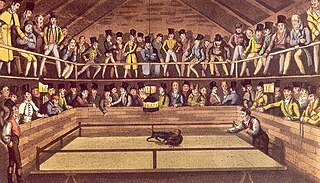
The Westminster Pit was a well-known blood sport arena in nineteenth-century London, England. It reached a zenith of popularity between 1820 and 1830, and hosted such spectacles as dog-fighting, cock-fighting, bear-baiting, badger-baiting, monkey-baiting, and rat-baiting. A legal enterprise at the time, the Westminster Pit openly declared its activities, ushering notoriety on the district in which it existed.
A ratter is any dog used for catching and killing rats and similar vermin. Specialized rat-catching breeds are found in many countries. A typical ratter is small to medium-sized and has a short and smooth coat, however a wide range of dog breeds and landraces may be used. The use of ratting dogs is widely considered to be the most environmentally friendly, humane and efficient methods of exterminating rodents. Ratting dogs are considered more efficient than domestic cats.
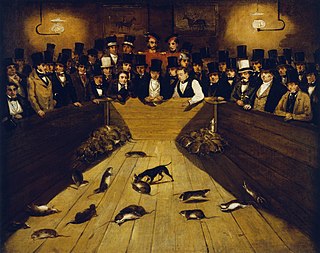
Tiny the Wonder was an English Toy Terrier famous in the City of London in the mid-19th century for being able to kill 200 rats in an hour in the city's rat-baiting pits. At the time, the world record for killing 100 rats was 5 minutes, 30 seconds, held by a bull and terrier named Billy.









